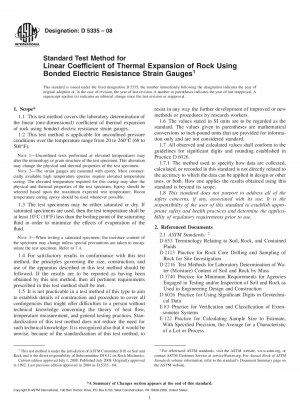ASTM D5335-08
Standard Test Method for Linear Coefficient of Thermal Expansion of Rock Using Bonded Electric Resistance Strain Gauges
- Standard No.
- ASTM D5335-08
- Release Date
- 2008
- Published By
- American Society for Testing and Materials (ASTM)
- Status
- Replace By
- ASTM D5335-14
- Latest
- ASTM D5335-14
- Scope
Information concerning the thermal expansion characteristics of rocks is important in the design of any underground excavation where the temperature of the surrounding rock may be altered. Thermal strain causes thermal stress that ultimately affects the stability of underground excavations. Examples of applications where rock thermal strain is important include: nuclear waste repositories, underground power stations, compressed air energy storage facilities, and geothermal energy facilities.
The linear coefficient of thermal expansion, α, of rock is known to vary as the temperature changes. Rock thermal strain is normally not a linear function of temperature. This test method provides a procedure for continuously monitoring thermal strain as a function of temperature. Therefore, information on how a changes with temperature is obtained.
Other methods of measuring the expansion coefficient of rock by averaging the thermal strain of a large specimen over a temperature range of many degrees may result in failure to determine the variation in α of that rock for one or more of the following reasons:
Alpha is not always linear with temperature,
Some rocks are anisotropic having directional characteristics which can vary by more than a factor of two.
Alpha may have a negative value in one direction and, at the same time, a positive value in the others.
Strain gauges, both wire and foil types, have been successfully employed to measure the thermal expansion coefficients of rock. These coefficients are frequently very small, being on the order of millionths of a millimetre per millimetre for each degree Celsius (millionths of an inch per inch for each degree Fahrenheit). The thermal strain of rocks is about one tenth that of plastics and one half or one quarter that of many metals. Therefore, measurement methods for rocks require greater precision than methods that are routinely used on plastics and metals.
Note 48212;Notwithstanding the statements on precision and bias contained in this test method; the precision of this test method is dependent on the competence of the personnel performing it, and the suitability of the equipment and facilities used. Agencies that meet the criteria of Practice D 3740
are generally considered capable of competent and objective testing. Users of this test method are cautioned that compliance with Practice D 3740 does not in itself assure reliable testing. Reliable testing depends on many factors; Practice D 3740 provides a means of evaluating some of those factors. 1.1 This test method covers the laboratory determination of the linear (one-dimensional) coefficient of thermal expansion of rock using bonded electric resistance strain gauges.
1.2 This test method is applicable for unconfined pressure conditions over the temperature range from 20 to 260°C (68 to 500°F).
Note 18212;Unconfined tests performed at elevated temperatures may alter the mineralogy or grain structure of the test specimen. This alteration may change the physical and thermal properties of the test specimen.
Note 28212;The strain gauges are mounted with epoxy. Most commercially available high temperature epoxies require elevated temperature curing. The elevated temperature required for this curing may alter the physical and thermal properties of the test specimen. Epoxy should be selected based upon the maximum expected test temperature. Room temperature curing epoxy should be used whenever possible.
1.3 The test specimens may be either saturated or dr......
ASTM D5335-08 Referenced Document
- ASTM D2113 Standard Practice for Rock Core Drilling and Sampling of Rock for Site Investigation
- ASTM D2216 Standard Test Method for Laboratory Determination of Water (Moisture) Content of Soil and Rock by Mass
- ASTM D3740 Standard Practice for Minimum Requirements for Agencies Engaged in the Testing and/or Inspection of Soil and Rock as Used in Engineering Design and Construction
- ASTM D6026 Standard Practice for Using Significant Digits in Geotechnical Data
- ASTM D653 Standard Terminology Relating to Soil, Rock, and Contained Fluids
- ASTM E122 Standard Practice for Calculating Sample Size to Estimate, With a Specified Tolerable Error, the Average for Characteristic of a Lot or Process
- ASTM E228 Standard Test Method for Linear Thermal Expansion of Solid Materials With a Vitreous Silica Dilatometer
- ASTM E289 Standard Test Method for Linear Thermal Expansion of Rigid Solids with Interferometry
- ASTM E83 Standard Practice for Verification and Classification of Extensometer
ASTM D5335-08 history
- 2014 ASTM D5335-14 Standard Test Method for Linear Coefficient of Thermal Expansion of Rock Using Bonded Electric Resistance Strain Gauges
- 2008 ASTM D5335-08 Standard Test Method for Linear Coefficient of Thermal Expansion of Rock Using Bonded Electric Resistance Strain Gauges
- 2004 ASTM D5335-04 Standard Test Method for Linear Coefficient of Thermal Expansion of Rock Using Bonded Electric Resistance Strain Gages
- 1999 ASTM D5335-99 Standard Test Method for Linear Coefficient of Thermal Expansion of Rock Using Bonded Electric Resistance Strain Gages
